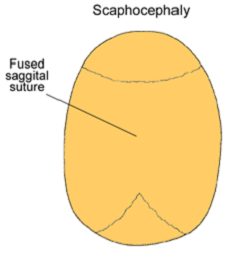Craniosynostosis
Traditional open surgery
What is craniosynostosis?
A baby’s skull has several bones. The spaces between these bones are called sutures. As a baby grows and develops, the sutures are where rapid growth occurs. In time, the brain stops growing. By the teen years the sutures close and form the solid bony skull.
Craniosynostosis means one or more of the sutures closed too early. This can cause problems with skull growth, and possibly brain growth.
- The shape of the skull will change depending on which suture is closed too soon. (See the next page for more pictures).
- More than one suture may close too early.
- The bones in the face also may not develop as they should.
A CT scan of your child’s head will be done to look at your child’s skull. Your surgeon will review the scan with you, and make recommendations.
When is surgery done?
The surgery is done by a craniofacial surgeon and a neurosurgeon. These surgeons will talk with you about the best time to do surgery. Your surgeons will explain what will happen during surgery. Please ask any questions you have.
What happens after the surgery?
- Your child will be admitted to the Intensive Care Unit. When well enough, your child will be moved to a regular room on the neurosurgery floor. Your child will likely be in the hospital for 3 to 5 days.
- There will be monitors attached to your child. The monitors check oxygen levels, breathing rate, heart rate and blood pressure.
- It is likely that your child will need one or more blood transfusions.
- The head of your child’s bed will be raised up 30 degrees to help reduce swelling.
- There will be some swelling on your child’s face and eyes within the first 48 hours after surgery. Your child’s eyes may be temporarily swollen shut.
- Pain medicine will be given as needed.
- Your child may wake up more often than normal. This is very common after surgery, and can last for a few weeks after going home from the hospital.
Diet
- Your child will have an IV in the hospital. This will allow for medications to be given, and prevent dehydration.
- Your child will go back to a normal diet when ready. First, your child will start with clear liquids, and solid foods will be added as tolerated.
Follow-up
- Your child will need to be seen in the Craniofacial Clinic within 7 to10 days after surgery.
- There will be an incision across your child’s head. Some types of stitches will need to be removed in the clinic.
- Your child will be followed closely after surgery. Ongoing follow-up with the craniofacial surgeon will continue during their childhood years.
Pictures are shown looking down from top of head.






